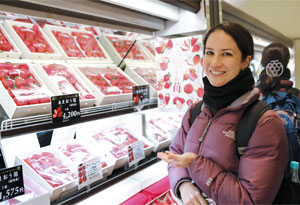The No-Plan Vacation: 4 Days. In Tokyo. No Itinerary. Just Letting Go.

Catherine Price took off for Tokyo with no guidebook and a wacky idea: Let strangers decide every detail of her trip. Four days, 29 brief encounters, one collapsible bicycle, eight octopus balls, 600 flesh-eating fish, one goma fire ceremony, and too much fried food later, she'd discovered the joy in letting go.
It was Friday night in Shinjuku, a Tokyo neighborhood famous for neon signs, subterranean shopping malls, and rent-by-the-hour lodgings known as love hotels. In crowded bars, people tipped back beers and sang karaoke. Young men with black jackets and gelled hair stood on street corners, offering menus of available escorts to passersby. In the midst of the action was a store window, covered except for a narrow strip of glass. If you were to have stopped and looked through it, you would have seen something strange: my legs, submerged to the ankles, with 600 flesh-eating fish feasting on my feet. This is the story of how I got there.
Like many people, I approach vacations with a level of preparation appropriate for a medical licensing exam—poring over Internet reviews, reading guidebooks cover to cover, and studying maps so I'm oriented from the moment my plane touches down. I research, I plan, I strategize, transforming my trips into long to-do lists I must conquer in order for them to be judged a success.
This tendency was in full effect during a recent week my husband and I spent on Kauai, when I broke the island into quadrants and made long lists of every activity we should do while "relaxing" in paradise. It was exhausting, and somewhere in the process, I started to ask myself why I was doing this. What was I trying to accomplish? What if, instead of meticulously planning, I were to just show up in a new place and let the experience unfold? By stage-managing every detail, I realized, I was ruining one of the best parts of travel: the adventure.
So I decided to take a different approach. I would go on a trip in which I relinquished control. No guidebook, no Internet research, no list of things to see or do. Instead, I would base all my activities, from where I stayed to what I ate or saw, on the recommendations of strangers. Even the destination would be chosen by someone else.
I started by approaching a woman in the fiction section of a San Francisco bookstore and asking her to tell me the most interesting place she'd ever been. She responded, "I love Tokyo," and two weeks later, I boarded a flight. I had a map. That was it.
The ambition of this project didn't fully sink in until the plane took off and I realized I was going to have to ask a stranger where to bunk. At first that made me nervous—aren't strangers the same people who steal wallets and kidnap children? But then I looked at the passengers around me. A woman in the next row wore a bumblebee neck pillow. The girl next to me had adorned each long, fake fingernail with a plastic Hello Kitty charm, as if worried a customs agent might demand a finger puppet show. These, I realized, were not the strangers my mother had warned me about.
The problem with guidebooks
Photo: Jun Takagi



